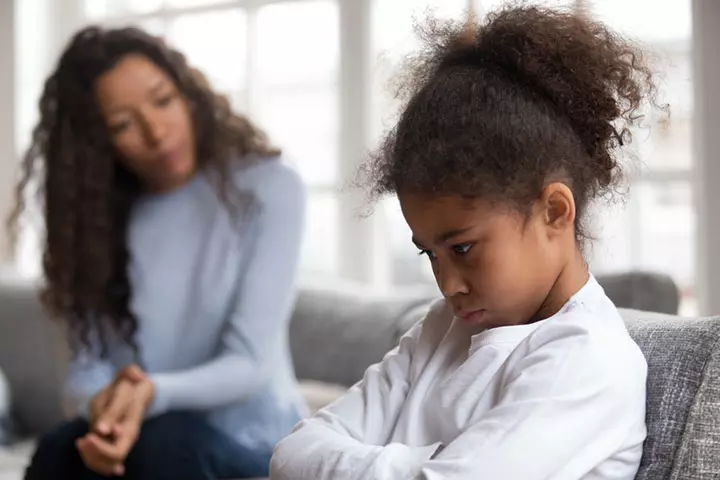
Image: Midjourney/ MomJunction Design Team
Parents of children often struggle with childhood tantrums and attitudes. So if you are one of them, we will help you understand how to deal with a stubborn child.
Stubbornness in children is natural, but this does not make the parent’s difficulties any less. Chores as simple as going to sleep, taking a bath, or eating can take a lot of convincing, ultimately leading to an argument. Dealing with this every day can be taxing. Therefore, it is essential to acquaint the child with the consequences of such behavior. You also need to appreciate their hard work and good behavior to get them to listen to you.
This post will help you with some tips to deal with a stubborn child.
Key Pointers
- Setting clear boundaries, along with their consequences, is required to handle stubbornness.
- However, parents must acquire active listening skills to be empathetic towards their children.
- Positive reinforcement helps to reduce stubbornness and allows children to feel acknowledged.
- Parents should avoid losing their temper, as it can have a negative impact on their children.
Reasons For Stubborn Behavior In Children
Research indicates that unfavorable behavior caused by aggression may be genetically inherited (21). While stubbornness may be a generic childhood trait, understanding why your child is stubborn may help you address it better and foster a harmonious family environment. Here are a few reasons why your child may be acting stubborn.
- A lower level of maturity
Children are at an age where they have yet to master the art of self-regulation. They often find themselves agitated when they are ill, hungry, sleepy, or bored, which makes them difficult to handle. They also get overstimulated easily and this may further contribute to their agitation (1).
- Need for autonomy
Children find their surroundings exciting and seek to explore the world, making attempts to discover their abilities and limitations. However, parents may be concerned about their safety and prevent them from doing certain things leading to defiance and stubborn behavior (2).
- Early exposure to screens
Studies indicate that early exposure to screens can cause issues with emotional management in children. With an increased dependence on screens, children may be exposed to fast-moving pictures, loud music, and negative role models which may make them overstimulated, anxious, and aggressive (3).
- Dealing with abuse or neglect
Children do not distinguish between positive and negative attention. Parental ignorance of the child’s basic needs such as food, water, comfort, and play tends to make children act stubbornly as a way to gain attention. Studies also indicate that children who undergo abuse tend to develop anger issues and strong-headedness as a way to protect themselves (4).
- Presence of a psychological condition
Stubbornness as a trait may be predominantly perceived in children with conditions such as autism spectrum disorders, mood disorders, attention deficit hyperactivity disorder, learning disabilities, down syndrome, and oppositional defiant disorder. This is often because of the confrontational, impulsive, and noncompliant behaviors that these children display (5).
- Faulty parenting styles
Parenting styles play a huge role in a child’s emotional and behavioral development. Children who have excessively restrictive or authoritarian parents tend to act out as a way to exert their independence. However, if parents are overly permissive they may unintentionally behave in ways that reinforce their children’s stubbornness, thereby increasing this tendency (6).
- Difficulty adapting to change
Children have a preference for set routines as they are familiar and comforting. However, any change in such routines tends to make them scared, agitated, and defensive, which may show up as stubbornness.
Characteristics Of A Stubborn Child
Not every child that exercises free will is stubborn. It is important to fathom if your child is stubborn or determined before taking any strong action. Strong-willed children can be highly intelligent and creative. They ask a lot of questions, which may come across as rebellion in kids. They have opinions and are “doers”. On the other hand, stubborn children stick to their opinion and would not be ready to listen to what you have to say.
Here are a few other characteristics that stubborn children may display
- They have a strong need to be acknowledged and heard. So they may seek your attention often.
- They could be fiercely independent.
- They are committed and bent on doing what they like.
- All children throw tantrums, but stubborn ones may do so more often.
- They have strong leadership qualities – they can be “bossy” at times.
- They like to do things at their pace.
Managing a stubborn child may be difficult, but it is not all bad.
 Experts say
Experts sayUnderstanding Stubborn Children
If determination is one of your strong suits, you’d love to see that in your children as well. But the tricky part is to know the difference between determination and stubbornness. So how do you tell one from the other?
- The dictionary meaning of determination is ‘firmness of purpose’.
- Stubbornness is defined as having an unwavering determination to do something or act in a particular way. Simply put, it is refusing to change one’s thoughts, behaviors, or actions regardless of the external pressure to do otherwise.
- Stubbornness in children can be genetic or an acquired behavior due to environmental influences (7).
Alyssa Roberts, a psychologist and research professional from Greater Minneapolis-St. Paul Area, says, “The factors that can contribute to children being stubborn or strong-willed are their developmental stage, temperament, parenting style, stressors, and unmet needs.”
Dealing with stubborn children might require extra patience and effort, as you would need to observe and understand your child’s behavior pattern carefully. Next, we will give you a few tips that might help in dealing with stubborn children.
Tips To Deal With Stubborn Children
You may have a stubborn toddler who refuses to stay in their crib or brushes aside their cereal spoon every time you try to feed them. Or you may have a bullheaded six-year-old who insists on wearing the same clothes every day and stomps their feet to defy every rule or instruction you give them.
Roberts opines, “Stubbornness or strong will can be a personality trait, but it is not necessarily fixed or permanent. Children’s behavior is influenced by internal and external factors, which can change over time as they grow and develop.
“If a child is misbehaving or exhibiting stubborn behavior, it’s important to understand the underlying cause and address it in a supportive and nurturing way. This could involve setting clear boundaries and expectations, providing security and stability, and offering positive reinforcement for desired behaviors. It may also be helpful to seek the guidance of a child psychologist or other mental health professional if the behavior is causing significant difficulties or concerns.”
Here are a few tips that could come in handy while dealing with the stubborn nature of your child.
1. Try to listen
Communication is a two-way street. If you want your child to listen to you, you have to be willing to listen to them first. Give your full attention, paraphrase what they say, and ask questions to understand better. Stubborn children may have strong opinions and tend to argue.
They may become defiant if they feel that they aren’t being heard. Most of the time, when your child insists on doing or not doing something, listening to them, having an open conversation about what’s bothering them, and validating their feelings can help in effective problem-solving. For example, if your child is throwing a tantrum to finish lunch, then do not force-feed your child. Instead, ask them why they do not want to eat and listen – it could be because they are playful or having a tummy ache.
Laura Kirmayer, a psychologist, emphasizes the importance of allocating dedicated time with your child in her insights at the Child Mind Institute. She recommends setting up a weekly date without fail with your child, despite your busy schedule. According to her, utilizing this time to connect with your child, creating a comfortable environment for open communication, and choosing their favorite meal or a place can make these moments even more special (22).
If you want your stubborn five-year-old child to listen to you, try to approach calmly and practically and not head-on.
2. Connect with them, don’t force them
When you force children into something, they tend to rebel and do everything they should not. The term that best defines this behavior is counterwill, which is a common trait of stubborn children. Counterwill is instinctive and is not restricted to children alone. Connect with your children.
For example, forcing your six-year-old child, who insists on watching TV past her bedtime, will not help. Instead, sit with them and show interest in what they are watching. When you show you care, children are likely to respond.
Children who connect with their parents or caregivers want to cooperate. “Establishing an unshakable connection with defiant children makes it easier to deal with them,” says Susan Stiffelman in her book Parenting Without Power Struggles.
Take that first step of connecting with your child today – hug them! (8)
3. Give them options
Stubborn children might have a mind of their own and don’t always like being told what to do. Instead, giving them options may reduce their defiant behavior and foster cooperation (23). Tell your stubborn four-year-old child that she has to be in bed by 9pm, and all you will get from them is a loud “No!”. Tell your adamant five-year-old child to buy a toy you chose; they will NOT want that. Give your children options and not directives to keep room for flexibility. Instead of telling them to go to bed, ask them if they want to read bedtime stories A or B.
Your child could continue to be defiant and say, “I am not going to bed!”. When that happens, stay calm and tell them matter-of-factly, “well, that was not one of the choices”. You can repeat the same thing as many times as needed, and as calmly as possible. When you sound like a broken record, your child is likely to give in.
Recounting how she dealt with her child’s stubbornness, an anonymous mother and blogger shares, “My daughter was very stubborn. She refused to try the big roller coasters, preferring the more subdued rides that the rest of the family found boring. It means she’ll enjoy different rides at the park. There’s no shortage of alternative options for her to enjoy. My husband and I decided to respect our daughter’s choice to choose to ride or not. We joined her on rides she found appealing, and she waited for our return on rides she didn’t feel ready for. Eventually, she decided on her own to try two roller coasters and discovered she really does enjoy them (ii).”
That said, too many options aren’t good either. For example, asking your child to pick one outfit from the wardrobe could leave them confused. You can avoid this problem by minimizing the options to two or three outfits picked by you and asking your child to pick from those.
4. Don’t argue
When dealing with a stubborn child, a parent’s aim is not to get even with their child or get the child to accept defeat. The ultimate goal is to ensure the child learns emotional and behavioral regulation. When you argue, you attempt to gain an upper hand forcing the child to bend to your will, eventually losing your patience and temper. You may even end up scolding or threatening them with exaggerated consequences and punishments. In such cases, children often end up either being more aggressive in putting forth their demands or getting traumatized due to your harsh disciplinary techniques. So it is best that you
- pick your battles and refuse to get into altercations by being aware of what triggers you and your child,
- take time and space to calm down when you feel provoked, threatened, or overwhelmed, and resolve the issue once you have a clear mind,
- convey to your child that you look at their point of view and appreciate them for putting it forth,
- resolve trivial issues by providing your child with choices,
- take an assertive approach in explaining your point of view,
- highlight the consequences in a non-threatening and respectful manner, and
- provide your child with some time to decide after insisting that both of you have only your best interests at heart.
The aim here is to remain respectful and feel a sense of comfort with the conclusion (9) (2).
5. Stay calm
Yelling at a defiant, screaming child will turn an ordinary conversation between a parent and a child into a shouting match. Your child might take your response as an invitation to verbal combat. This will only make things worse. It is up to you to steer the conversation to a practical conclusion as you are the adult. Help your child understand the need to do something or behave in a specific manner.
Monika Sahay, a mother of one, faced various challenges while managing her strong-willed child. Sharing her learnings she says, “At the beginning of this journey, I thought I could just outlast my anger, frustration, irritation, etc. Then I realized that I’m a grown-up, after all. Getting angry at him, hitting him, or screaming at him isn’t going to teach him anything. What I didn’t realize at the time is that no one outlasts a toddler. A huge aspect of the general ethos of parenting is finding teachable moments. But stubborn kids don’t want to learn from teachable moments, and no one will make them. And if you think you can, well, they will hold their breath until they pass out and teach you something. So, I concluded that being calm and patient is the only solution (i).”
Do what it takes to stay calm – meditate, exercise, or listen to music. Play calming or relaxing music at home so that even your children can listen. Once in a while, play your child’s favorite music. That way, you can gain their ‘vote’ and also enable them to unwind.
 Quick tip
Quick tip6. Respect them
Your child would probably not accept authority if you forced it onto him. So here are a few ways you can model respect and supportiveness in your relationship:
- Seek cooperation, don’t insist on adherence to directives.
- Have consistent rules for all your children, and do not be lax just because you find it convenient.
- Empathize with them – never dismiss their feelings or ideas.
- Let your children do what they can for themselves, avoid the temptation to do something for them, to reduce their burden. This also tells them that you trust them.
- Say what you mean and do what you say.
Lead by example is the mantra you should follow here because your children are observing you all the time, according to Betsy Brown Braun, the author of You’re Not The Boss Of Me.
7. Work with them
Stubborn or strong-willed children are highly sensitive to how you treat them. So be watchful of the tone, body language, and vocabulary you use. When they become uncomfortable with your behavior, they do what they know best to protect themselves: they rebel, talkback, and display aggression.
- Changing the way you approach a stubborn child can change how they react to you. Rather than telling them what to do, partner with them.
- Use statements like “let’s do this…”, “how about we try that…” instead of “I want you to do … ”.
- Use fun activities to get your children to do something. For example, if you want your stubborn child to put their toys away, start doing it yourself and ask them to be your “special helper”.
- You could also time the activity and challenge the child to put the toys away faster than you can. This is a sneaky trick that mostly works.
8. Set the boundaries
A strong-willed child requires clear guidelines and consistency on what is acceptable behavior. They need visual and accessible reminders of the rules, rewards, and consequences (11) (9) (2).
- Start by preparing a list of age-appropriate terms of conduct with pictures to make it easier for them to understand and remember.
- When a rule is consistently followed, make sure to reward them as this works to keep them motivated.
- Avoid giving harsh punishments. Instead, spell out functional consequences (such as written reflection or time outs) for boundary breaches and follow through with them.
- Avoid being a hypocrite. Show respect for your child’s boundaries and consider giving a leeway when their requests are reasonable.
- Go over the boundaries regularly and revise them as your child grows to ensure they remain age-appropriate.
Lastly, ensure that the boundaries you set have enough flexibility to accommodate unexpected events and quick negotiations.
9. Negotiate
Sometimes, it is necessary to compromise and negotiate with your children. It is common for them to act out when they aren’t getting what they want. If you want them to listen to you, you need to know what’s stopping them from doing so.
- Start by asking a few questions like, “What is bothering you?” “Is something the matter?” or “Do you want anything?” to get them to talk about it. This tells them that you respect their wishes and are willing to consider them.
- Negotiation need not necessarily mean that you always give in to their demands. It’s all about being considerate and practical.
- For example, your child may not be willing to go to bed at a set hour. Rather than insisting, try and negotiate a bedtime that suits both of you.
10. Create a congenial environment at home
Children learn through observation and experience (12). If they see their parents arguing all the time, they will learn to imitate that. Marital discord between parents can lead to a stressful environment in the house, affecting the mood and behavior of the children. According to a study, marital discord may lead to social withdrawal and even aggression in children (13). So before you expect your child to behave in a certain way, indulge in self-reflection and ensure you practice positive role modeling.
11. Be a role model
Children are also experts in imitating something they see. When a child observes a parent getting agitated by their stubbornness, they tend to imitate their reactions. The child is also likely to have a similar response to your ignorance. Therefore, you need to ensure you model the right behavior (11) (9) (2).
- Use respectful language when disagreeing on something. Model assertiveness and negotiation skills during conflicts.
- Exhibit flexibility when complying with requests and ensure that you respectfully follow the house rules.
- Convey your love towards your children through loving words and affectionate gestures.
- Ensure that you neither throw temper tantrums nor admit defeat. Instead, model effective communication.
12. Understand the child’s perspective
To better understand your stubborn child’s behavior, try to look at the situation from their perspective and practice empathy. Put yourself in your child’s shoes and try to imagine what they must be going through to behave in such a way. The more you know your child, the better you can deal with their stubborn streak.
Empathize with the child even while not giving in to their demands. You can understand their disappointment, anger, or frustration and support them whilst being firm and assertive.
For example, if your child is not willing to do their homework, he or she is overwhelmed by the task. If there is too much to do or if your child is not able to focus, you can help by breaking the homework into smaller tasks that can be completed in a short time. You could include short, one or two-minute breaks between the tasks to make the activity less stressful for them.
13. Reinforce positive behavior
There will be times when you would not know what to do with stubborn children to control their anger and aggressive behavior. But if you react without thought, you may develop a negative attitude towards the problem and even reinforce their negative behavior unwittingly.
For example, your child may be saying “No!” to almost everything you say. Think about it – do you say “No” a lot? If yes, you are reinforcing negative behavior by example.
One way to change your stubborn child’s negative responses is the “Yes” game, a clever strategy recommended by marriage and family therapist Susan Stiffelman.
When playing this game, your child has to say “yes” or “no” to everything. Questions like “You love ice cream, don’t you?” “Do you love playing with your toys?” or “Do you want to see if your dinosaur floats in the bathtub tomorrow?” are likely to get a “Yes” from your child. The more your child responds positively, the more they are likely to feel like they are being heard and appreciated.
 Experts say
Experts say14. Reward them
It so happens that with a stubborn child, you tend to pay more attention to their non-compliance, temper tantrums, and other misbehaviors. Parents tend to overlook certain positive qualities that these children possess including persistence, perseverance, goal orientation, strong decision-making skills, honesty, and fearless self-expression. Such behaviors depict the strength in their character and highlight their ability to be natural leaders. As parents, you must stay attuned to your child’s good behaviors and focus on enriching these positive qualities through rewards.
Rewards have the power to make your child feel seen and accepted. They encourage good behaviors, improve parent-child bonding, and enhance self-esteem. Rewards need not necessarily be big gifts or grand gestures. They may be simple tokens of appreciation such as a ‘good job’ on doing their homework or a ‘you are my super helper’ sticker upon finishing a chore. You may even give them non-materialistic rewards such as extended playtime or a trip to their favorite place when they comply with your requests or show consistent adherence to the household rules. Spending time with them at times is also a reward enough for children when they feel isolated and neglected (14) (11) (9).
15. Develop daily routines
Children thrive when they have a fixed routine that they can adhere to. The stability of having routines provides them with a sense of security and helps them self-regulate. It also helps them develop social skills and provides them with a sense of control over their life. Routines also encourage discipline and ensure that a child’s basic needs are met. They also help parents and other caregivers keep track of a child’s schedule. It also helps children get preparatory warnings on transitions between routines (15).
- Daily routines have fixed time slots for all activities that a child has to accomplish in a day. It may include daily hygiene, play, sleep, and leisure activities.
- For school-going children, daily routines may also outline when they are expected to study or do homework.
- It can also include pictures for easy comprehension and blank spaces for impromptu events.
- Finally, ensure that you include a column for putting up stickers of appreciation.
How To Deal With Some Common Problems With A Stubborn Child
Here are some common issues parents are likely to face while dealing with a stubborn child
1. How to potty train a stubborn child?
Potty training is difficult as it is, but when you are dealing with a stubborn child, it can become a pain. You can potty train your three-year-old stubborn and aggressive child by:
- Talking about it.
- Explaining to them how it is done.
- Making it fun – don’t get serious if your child refuses to use the toilet.
Remember that a stubborn child may take longer to learn to use the toilet than an obedient one. So remain patient and work with your child to help them reach the goal, rather than push them towards it. Consistency and perseverance in efforts will help the child to learn faster and reinforce positive behavior.
2. How to get them to eat?
Children tend to be very fussy when it comes to food. That said, you cannot always feed your child what they want. The best way to make sure your stubborn children get what is good for them is to make dinner time fun.
- Use creative ways to present food to your little one.
- Get them involved at the dinner table (ask them to set the table up, serve, etc.).
- Encourage them to try the food (just one bite) before rejecting it. Serve them small portions of everything and let them choose.
- Reward them with a dessert or treat for positive encouragement if they finish their meal.
3. How to punish a stubborn child?
Children need rules and discipline. Your child should know that there will be consequences, good or bad, for their actions.
Make sure that they are fully aware of the consequences of breaking the rules.
Consequences should be immediate, especially when dealing with children, so they can connect their actions to the result. Time-outs, cutting down playtime or TV time and assigning little chores can be a few ways to discipline the child. You could also get creative with consequences based on the problem. If your child is scribbling on walls or using foul language, calmly explain why it’s wrong and set clear consequences. For instance, say, ‘If you keep scribbling on the walls, your playtime will be shorter (11) (24).’
Remember that the idea is not to punish the child but make them realize that their behavior is wrong.
4. How to deal with stubbornness in a child with special needs?
A child with special needs has a psychological or physiological disability. Such children have problems with regular functioning and require different kinds of assistance based on their condition. However, such children too seek to be independent and achieve something in their lives (16). With proper parental education and timely guidance for the child, behavioral issues in children with special needs may be addressed. Yet before we begin, you must understand the reasons for such behavior in a child with special needs.
The reasons for stubbornness in children with special needs are that they have issues with communicating needs, forming relationships, impulse control, sustained attention, organization, task completion, frustration sensitivity, compliance, obedience, and self-esteem. They also are unable to understand instructions or take no for an answer. Children with special needs tend to have extreme mood swings and often find it difficult to adapt to changes (17) (18) (5).
A few ways in which parents can deal with stubbornness in children with special needs include
- Giving time warnings to prepare them in advance for a change of activity or place.
- Providing visual aids such as lists and labels for increased comprehension.
- Setting priorities and adding reminders to facilitate task accomplishment.
- Using simple phrases and statements when communicating to help them understand instructions and information better.
- Having a set routine that they can follow to take care of personal hygiene needs.
- Ensuring increased participation in familial and peer group activities to facilitate social interaction.
- Planning for unexpected situations to be better equipped to handle mood swings and temper tantrums.
- Rewarding good behavior to facilitate repetition.
- Ensuring you maintain a calm exterior when dealing with difficult situations to avoid agitating them further.
- If your child’s behavior remains unsettling despite implementing these measures, seeking professional medical guidance is advisable.
Frequently Asked Questions
1. What are some of the causes for my child to become stubborn?
There can be several reasons for a child to exhibit stubborn behavior. For instance, some children may behave stubbornly due to their strong-willed temperament, while others may behave so due to a lack of boundaries and rules or inconsistent discipline. In some other cases, children may behave obstinate because they have observed you or some other adult, such as an elder sibling, behave stubbornly.
2. Is it normal for my child to be stubborn?
It is normal for children to behave stubborn at times. A growing sense of autonomy and curiosity to learn about the world around them are the most common reasons that can make a child stubborn. However, it is essential to set clear boundaries and consequences for inappropriate or unacceptable behavior while encouraging healthy communication to help children develop positive behavioral traits.
3. Is stubbornness genetic among children?
Research indicates that 20-60% of temperament is determined by genetics (19). However, there’s no clear pattern of inheritance. Also, there are no specific genes that are known to confer specific temperamental traits. Rather, large studies demonstrate that several genes play a role in temperament.
4. Are gifted children more stubborn?
Gifted children are innately impulsive and curious. They consider themselves superior and like to encounter challenges that are more advanced in comparison to their academic boundaries. Their strong will makes them defiant towards authority figures and the rules they impose. They also get easily frustrated and lash out when they are restricted from following their heart, thus making them seem extremely stubborn (20).
Stubbornness in children is common, but dealing with it daily may be exhausting for parents. However, knowing some tips on how to deal with a stubborn child could be helpful. While you must remain calm, listen to your child, and respect their opinions, do not give in to their demands; you might try giving them options and negotiating with them. You may also discipline them, but remember that the goal is not to punish the child but to make them know their conduct is inappropriate.
Infographic: Tips On Dealing With Stubborn Children
Stubborn children usually resist attempts to alter their conduct and frequently reject following rules or directions. Therefore, it may be challenging for parents to establish and uphold their authority, resulting in power struggles. To help you navigate these challenges, this infographic offers advice on coping with stubborn children. Illustration: Momjunction Design Team
Illustration: Ten Ways To Deal With A Stubborn Child
Image: Dall·E/MomJunction Design Team
Discover practical ways for dealing with stubborn children. Learn essential ideas and tactics for efficiently managing challenging behaviors and cultivating a supportive and constructive atmosphere.
Personal Experience: Source
MomJunction articles include first-hand experiences to provide you with better insights through real-life narratives. Here are the sources of personal accounts referenced in this article.
i. Dealing with a stubborn child – My story;https://lifeexperiencesthroughblog.blogspot.com/2021/01/dealing-with-stubborn-child-my-story.html
ii. The Stubborn Child;
https://mealtimehostage.com/2016/09/13/the-stubborn-child/
References
- Challenging behaviour – toddlers and young children; The Royal Children’s Hospital Melbourne.
https://www.rch.org.au/kidsinfo/fact_sheets/challenging_behaviour_toddlers_and_young_children/ - How to Cope with a Stubborn Toddler; Riley Hospital for Children at Indiana University Health.
https://www.rileychildrens.org/connections/how-to-cope-with-a-stubborn-toddler - Sudheer Kumar Muppalla et al.; Effects of Excessive Screen Time on Child Development: An Updated Review and Strategies for Management; NCBI(2023)
https://www.ncbi.nlm.nih.gov/pmc/articles/PMC10353947/ - Abdulaziz Al Odhayani et al.; Behavioural consequences of child abuse; NCBI(2013);
https://www.ncbi.nlm.nih.gov/pmc/articles/PMC3743691/ - Parenting Children with Learning Disabilities ADHD and Related Disorders; Learning Disabilities Association of America.
https://ldaamerica.org/info/what-do-parents-of-children-with-learning-disabilities-adhd-and-related-disorders-deal-with/ - Samiullah Sarwar; Influence of Parenting Style on Children’s Behaviour; Journal of Education and Educational Development.
https://files.eric.ed.gov/fulltext/EJ1161470.pdf - Kimberly J. Saudino; Behavioral Genetics and Child Temperament; NCBI(2005).
https://www.ncbi.nlm.nih.gov/pmc/articles/PMC1188235/ - Cuddling Does Kids (and Parents) Good; Children’s Hospital Los Angeles.
https://www.chla.org/blog/rn-remedies/cuddling-does-kids-and-parents-good - Tips for Parenting Strong-Willed Children; ChildrensMD.
https://childrensmd.org/browse-by-age-group/toddler-pre-school/the-strong-willed-child-5-ways-to-turn-tension-into-joy/ - Taming Tempers; Nemours KidsHealth.
https://kidshealth.org/en/parents/temper.html - Disciplining Your Toddler; Nemours KidsHealth.
https://kidshealth.org/en/parents/toddler-tantrums.html - Francesca Foti et al.; Are young children able to learn exploratory strategies by observation?; NCBI(2018).
https://www.ncbi.nlm.nih.gov/pmc/articles/PMC6132659/ - Paul R. Amato and Juliana M. Sobolewski; The Effects of Divorce and Marital Discord on Adult Children’s Psychological Well-Being; JSTOR Journals.
https://www.jstor.org/stable/3088878?seq=1 - Tips for Using Rewards.
https://www.cdc.gov/parenting-toddlers/discipline-consequences/using-rewards.html - Routines Provide Stability for Kids; Youth First.
https://youthfirstinc.org/routines-provide-stability-for-kids/ - Kids With Special Needs; Nemours KidsHealth.
https://kidshealth.org/en/kids/special-needs.html - David Stein; Behavior and Down Syndrome: A Practical Guide for Parents; Boston Children’s Hospital.
https://dsagsl.org/wp-content/uploads/2014/04/Behavior-Guide-for-Down-Syndrome.pdf - Tips that Improved My Autistic Child’s Behavior; Autism speaks.
https://www.autismspeaks.org/blog/five-tips-helped-improve-my-childs-behavior - Genetics understanding traits temperament; National Library of Medicine.
https://medlineplus.gov/genetics/understanding/traits/temperament/ - Is Your Child Gifted? Characteristics of Gifted Children; Oak Crest Academy.
https://oakcrestacademy.org/is-your-child-gifted-characteristics-of-gifted-children/ - Emiko Koyama et al., Genetics of child aggression, a systematic review.
https://pmc.ncbi.nlm.nih.gov/articles/PMC11167064/#:~:text=It%20has%20been%20found%20that - My 9-year-old won’t listen to me, and I don’t have much patience with her anymore. Any suggestions?
https://childmind.org/article/my-9-year-old-wont-listen-to-me-and-i-dont-have-much-patience-with-her-anymore-any-suggestions/ - How to Help Children Calm Down.
https://childmind.org/article/how-to-help-children-calm-down/ - How to discipline your child a smart and healthy way.
https://www.unicef.org/parenting/child-care/how-discipline-your-child-smart-and-healthy-way
Community Experiences
Join the conversation and become a part of our nurturing community! Share your stories, experiences, and insights to connect with fellow parents.
Read full bio of Michelle Bowyer
- Alyssa Roberts is a student of psychology, pursuing her masters program in Counseling and Psychological Services. She has worked as a health volunteer for several years in a group home setting, children’s day treatment, rehabilitation clinic, and in community mental health. She is particularly interested in adolescent psychology and neuropsychology.
 Alyssa Roberts is a student of psychology, pursuing her masters program in Counseling and Psychological Services. She has worked as a health volunteer for several years in a group home setting, children’s day treatment, rehabilitation clinic, and in community mental health. She is particularly interested in adolescent psychology and neuropsychology.
Alyssa Roberts is a student of psychology, pursuing her masters program in Counseling and Psychological Services. She has worked as a health volunteer for several years in a group home setting, children’s day treatment, rehabilitation clinic, and in community mental health. She is particularly interested in adolescent psychology and neuropsychology.
Read full bio of Sagari Gongala
Read full bio of Swati Patwal
Read full bio of Apoorva K


























